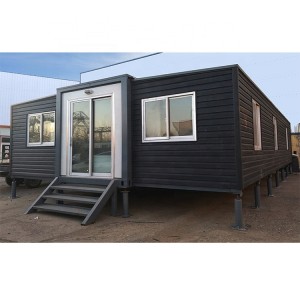The concept of living container:
The residential container is mainly based on the second-hand freight container. As a ready-made building material, the doors and windows are directly installed on the second-hand container, and the inner layer is added with thermal insulation materials. It is convenient for sea and land transportation and hoisting, and it can also save transportation costs. According to the requirements of standard containers, the residential container is divided into two to four and reassembled for transportation. It only needs to be transported from the factory to the site and placed on the flat ground for use. Residential containers can also be stacked and installed, and after the stacked layers are fixed, a multi-storey building is formed.
Advantages of living containers:
The cost of living in a container is low, the transportation is very convenient, and the installation is also very fast. Its mobility has irreplaceable advantages.
(1): Standardized and large-scale production of residential containers. The components are relatively standard, there are no complex components, and the degree of mechanization is high in the process of processing. It is completed on the assembly line to ensure the quality. At the same time, considering the tightness of packaging and transportation, a nested section is adopted.
(2): The transportation method is flexible and economical. In order to reduce the volume of transportation, the components that make up the occupancy container can be compressed and packaged before the single occupancy container is packed and transported. The wall, door, window and installation accessories in the living container are placed between the frame of the bottom and the top of the container. According to the different indoor layouts of single-occupancy containers, two (with more built-in walls) or three or four single-occupancy containers can be compressed to form a standard 20ft container, which reduces transportation costs. The overall dimensions of the single-occupancy container are standard container metric dimensions, and the four corners are fixed with container corner fittings, which are suitable for container trucks and container ships.
(3): On-site installation of residential containers is convenient and fast. The ready-made unit modules of second-hand containers provide the simplest and most reliable and sturdy building basic structural units that can be mass-produced for temporary buildings. Common use does not require pouring concrete floors, which can reduce a lot of pre-construction costs and time. According to the actual work experience, the cost of the entire project can be reduced by 30%. The top, bottom, enclosure panels, doors and windows and other components of the single-occupancy container are standardized by the factory to reduce the strength of on-site installation.
(4): There are various forms of space combination. Multiple single-occupancy containers can be assembled up, down, left and right to form a building space that meets various usage requirements, and can be combined into two-storey, three-storey buildings, etc. The internal partition wall of the box-type room can be disassembled and assembled arbitrarily to form a large indoor space.
Post time: Mar-02-2022








